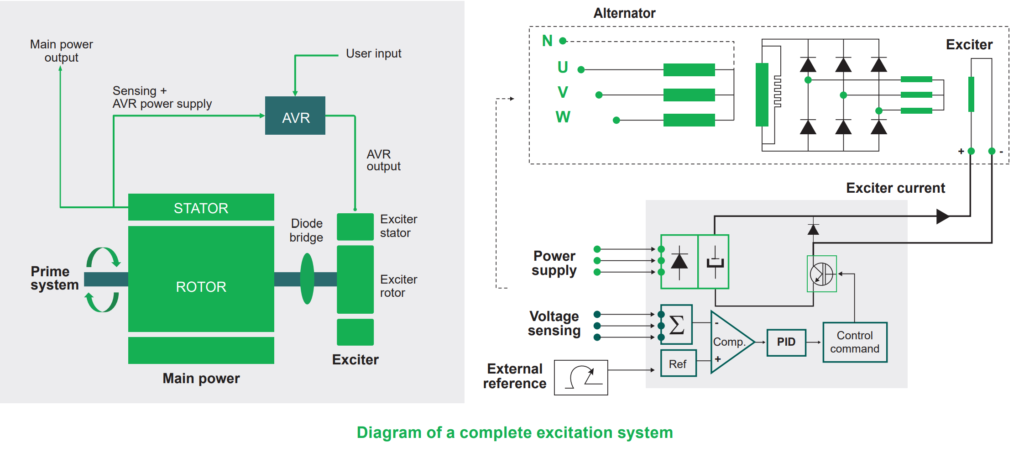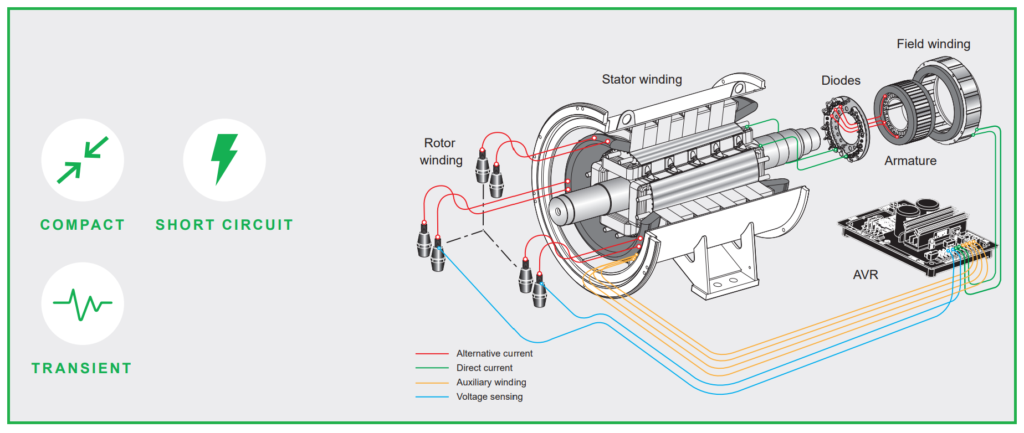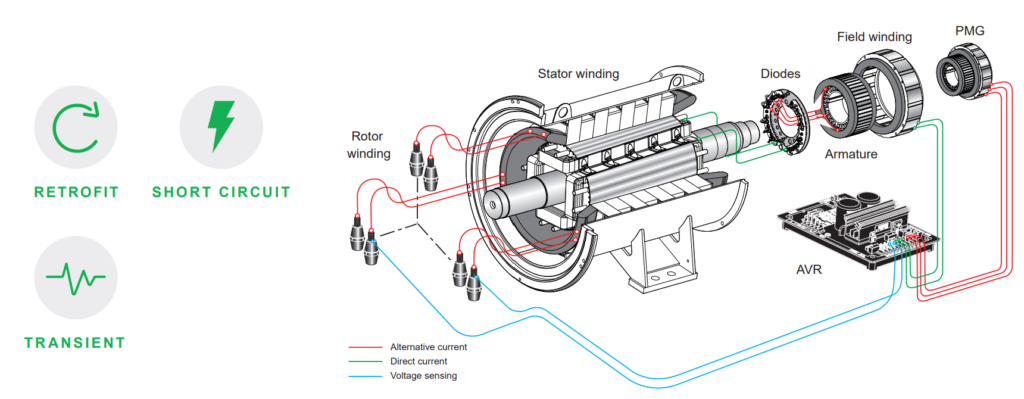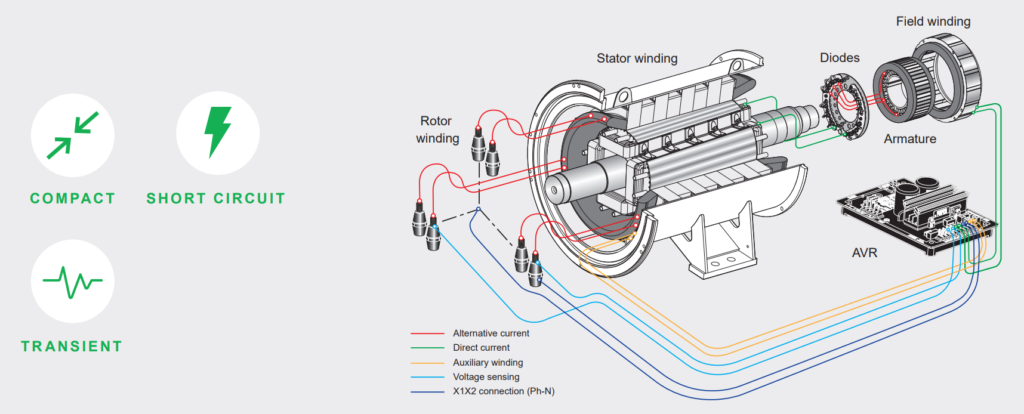Generators are essential components of electrical power systems, and their reliable operation depends on precise control of voltage output. Exciters play a crucial role in achieving this control. They are specialized systems designed to regulate the voltage produced by generators and ensure stable and consistent power generation.

2. DC Exciters:
Overview: DC exciters are a type of excitation system commonly used in generators. They generate direct current (DC) power and supply it to the field winding of the main generator. This controlled DC current influences the strength of the magnetic field in the generator’s rotor, ultimately determining the generator’s voltage output.
Voltage Control: The primary function of a DC exciter is to control the voltage produced by the generator. By adjusting the strength of the magnetic field in the generator’s rotor (achieved by varying the DC current supplied to the field winding), the exciter ensures that the generator produces electricity at the desired voltage levels.
Stability: Voltage stability is crucial in electrical power systems. The exciter helps maintain a steady and stable voltage output, even when the electrical load on the generator fluctuates. This stability ensures that the connected electrical grid or loads receive a consistent power supply.
3. AC Exciters:
Overview: In contrast to DC exciters, AC exciters use an alternating current (AC) power source, often derived from the generator itself or an auxiliary source. This AC power is then rectified into DC power, which is supplied to the generator’s field winding. These systems are more complex than DC exciters but offer advantages in certain applications.
Voltage Control: AC exciters also play a critical role in regulating generator voltage. They adjust the strength of the magnetic field in the same way as DC exciters but use a different method to generate the required DC power.
4. Advanced Excitation Control Systems:
Modern generators employ advanced excitation control systems that include electronic regulators. These regulators monitor various parameters, such as generator voltage, current, and frequency, to make rapid adjustments to the exciter’s output. This ensures that the generator responds swiftly to changes in load conditions and maintains system stability.
5. Protective Functions:
Excitation systems often include protective functions to safeguard the generator from overexcitation or overheating. If the exciter detects any abnormal conditions, it can take corrective actions, such as reducing the field current, to prevent generator damage.
6. Exciter Synchronization:
In situations where multiple generators are connected to a power grid, the excitation system helps ensure that the generators are synchronized in terms of voltage and frequency before they are connected to the grid. This synchronization is crucial to prevent electrical disturbances.
In summary, exciters in generator systems are essential for precise voltage control and stable power generation. Whether they are DC or AC exciters, their role is to provide accurate regulation of the generator’s field current, ensuring reliable electricity production and grid stability.
Shunt Excitation System
Overview:
In a shunt excitation system, the Automatic Voltage Regulator (AVR) is connected in parallel (shunt) with the generator’s output terminals. This design is relatively simple and cost-effective, making it suitable for standard generator applications. However, it may not be the best choice for situations with high short-circuit currents, such as motor start-up scenarios.

Key Characteristics:
- AVR Function: The AVR in a shunt excitation system generates and regulates the excitation current based on the alternator’s output voltage. Its primary role is to maintain the generator’s output voltage within the desired range.
- Simplicity: Shunt excitation systems are straightforward in design and operation, making them easy to implement and maintain. They are well-suited for standard generator setups where complexity is not a requirement.
- Cost-Effective: This system is cost-effective, as it doesn’t require additional components like PMG (Permanent Magnet Generator) or AREP (Auxiliary Winding with Rotating Exciter Pole) systems.
Limitations:
- Short Circuit Capability: Shunt excitation systems may not provide the necessary excitation current for scenarios with high short-circuit currents, such as motor start-up. This limitation can lead to voltage dips and instability during such events.
- Additional Boosters: In larger installations or situations requiring higher short-circuit capability, shunt excitation systems can be augmented with booster systems. These boosters incorporate current transformers in the terminal box to extend the supply voltage range. However, this solution adds complexity and cost to the system.
- Transformer Cost: The addition of current transformers to implement a booster system increases the overall cost of the installation due to the purchase and installation of these transformers.
Considerations:
When selecting an excitation system for a generator, it’s essential to consider the specific requirements of the application. Shunt excitation systems are suitable for standard applications where cost-effectiveness and simplicity are priorities. However, for more demanding scenarios with high short-circuit currents, alternatives like PMG or AREP systems may be preferred to ensure stable operation during events like motor start-ups. Additionally, the decision to add a booster system should be carefully evaluated, considering both the benefits and added costs.
Permanent Magnet Generator (PMG) Excitation System
Overview:
The PMG excitation system is a specialized method for providing power to the Automatic Voltage Regulator (AVR) in a generator. In this system, a Permanent Magnet Generator, or PMG, generates a constant voltage that serves as the power supply for the AVR. PMG excitation systems are known for their high overload and short-circuit capacities, making them suitable for demanding applications.

Key Characteristics:
- PMG Function: The primary feature of the PMG excitation system is the use of a permanent magnet generator mounted on the generator’s shaft extension at the non-drive end. This PMG generates a constant voltage independently of the main alternator winding.
- High Overload Capacity: PMG systems are capable of handling high overload conditions, with some models supporting short-circuit capacities of up to 300% for 10 seconds. This capability is valuable in applications where rapid changes in load occur.
- Remanent Magnetism: The permanent magnets used in the PMG ensure that there is enough remanent magnetism to initiate the system’s startup, even after extended shutdown periods. This feature enhances system reliability.
- Compatibility: PMG excitation systems can be installed on both new generators and existing machines with different excitation systems, such as SHUNT or AREP. They offer flexibility and can be retrofitted to meet specific requirements.
PMI Inserts as an Alternative:
As an alternative to a complete PMG system, generators with SHUNT, AREP, or AREP+ excitation systems can be enhanced with Permanent Magnet Inserts (PMI). These PMI inserts involve mounting permanent magnets on the exciter stator poles, providing some of the benefits of a full PMG system without the need for a complete overhaul.
Considerations:
PMG excitation systems are preferred when generators need to handle rapid load changes and high short-circuit currents. Their constant voltage output and reliable remanent magnetism make them suitable for critical applications. Additionally, the flexibility of retrofitting PMG systems to existing generators is a valuable feature for upgrading older machines. However, the choice of excitation system should always align with the specific needs and demands of the generator’s intended application.
AREP Excitation System
Overview:
The AREP (Auxiliary Winding with Rotating Electronic Power supply) excitation system is a type of generator excitation system used to regulate and control the voltage of an alternator. It provides a stable power supply to the Automatic Voltage Regulator (AVR) through two separate auxiliary windings, offering distinct advantages for specific applications.

Key Characteristics:
- Dual Auxiliary Windings: The primary feature of the AREP excitation system is its use of two separate auxiliary windings: H1 and H3. Each winding serves a unique purpose in regulating the generator’s output.
- H1 Winding (Voltage Proportional): The voltage delivered by the first auxiliary winding, H1, is directly proportional to the alternator’s output voltage. This characteristic resembles the SHUNT excitation system.
- H3 Winding (Current Proportional): The voltage delivered by the second auxiliary winding, H3, is proportional to the current drawn by the alternator. This proportionality is linked to the applied load, resulting in a “booster effect.” H3 helps maintain stable excitation levels under varying load conditions.
- Independent Power Supply for AVR: One of the notable advantages of the AREP system is that the power supply to the AVR’s power circuit is independent of the voltage sensing mechanism on the alternator’s output terminals. This isolation ensures that voltage distortions, such as harmonics caused by the load, do not affect the excitation current provided by the AVR to the alternator exciter.
- High Short-Circuit Capability: AREP excitation systems are known for their high short-circuit capability, with some models supporting up to 300% of the rated current for 10 seconds within the LSA range. This feature is valuable in applications where rapid changes in load or short-circuit conditions may occur.
Advantages:
- Voltage and current proportionality provide excellent control over the generator’s output, allowing it to respond effectively to varying loads.
- Independence of the power supply for the AVR from voltage sensing minimizes the impact of voltage distortions due to the load.
Considerations:
AREP excitation systems are well-suited for applications where load variations are significant, and stable voltage regulation is critical. Their high short-circuit capability enhances their suitability for situations with potential short-circuit conditions. However, the choice of excitation system should always align with the specific needs and demands of the generator’s intended application.